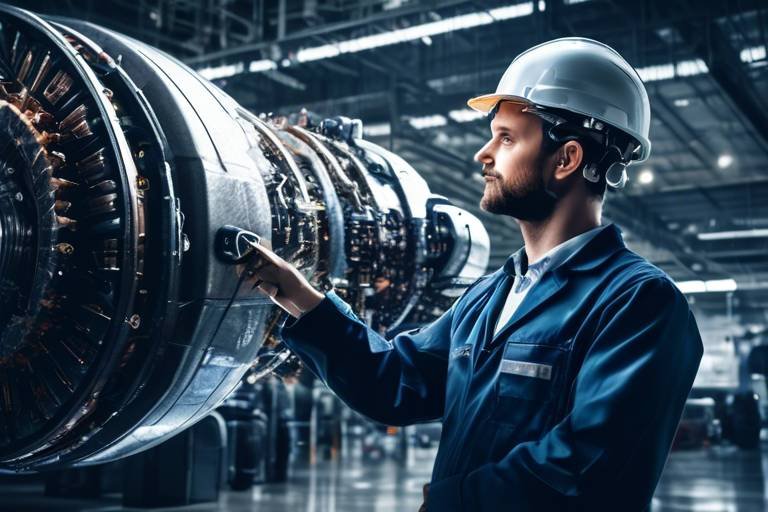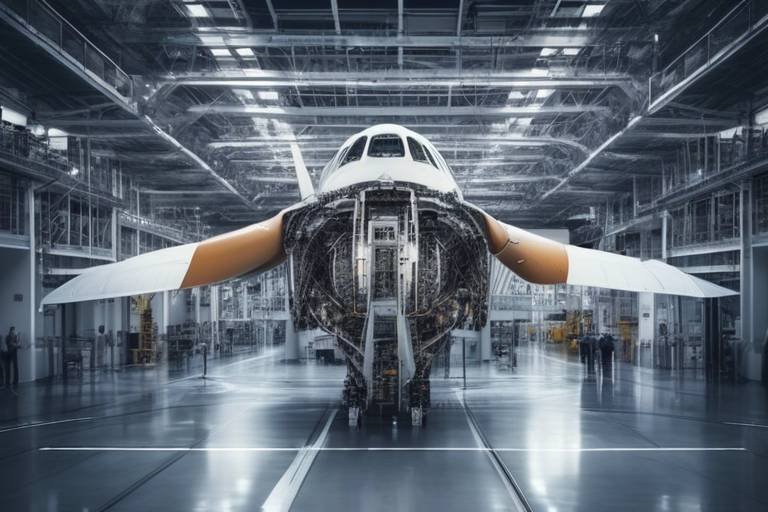How AI is Transforming Predictive Maintenance
In today's fast-paced industrial landscape, the integration of artificial intelligence (AI) into predictive maintenance strategies is nothing short of revolutionary. Imagine a world where machines can "think" and "predict" their own failures before they even happen. Sounds futuristic, right? Well, it’s happening now! AI is not just a buzzword; it’s a game-changer that is reshaping how industries approach maintenance. By leveraging advanced algorithms and data analytics, AI enhances the ability to foresee equipment failures, thus optimizing maintenance schedules and minimizing downtime. This proactive approach leads to a significant increase in operational efficiency and reliability.
The core of AI's transformative power lies in its ability to analyze vast amounts of data in real-time. Traditional maintenance strategies often rely on scheduled checks or reactive measures, which can lead to unexpected breakdowns and costly repairs. In contrast, AI-driven predictive maintenance uses data from sensors, historical performance, and operational conditions to identify patterns and anomalies. This means that organizations can shift from a reactive to a proactive maintenance model, where they can anticipate issues before they escalate.
Picture this: a manufacturing facility with hundreds of machines operating simultaneously. Each machine generates a plethora of data points—from temperature and vibration levels to operational hours. AI systems can sift through this data, identifying trends that human analysts might miss. For instance, if a machine's vibration levels start to increase beyond normal thresholds, the AI can alert maintenance teams to investigate further, potentially preventing a catastrophic failure. This is not just about fixing things when they break; it’s about ensuring that everything runs smoothly and efficiently.
Furthermore, the benefits of AI in predictive maintenance extend beyond just machinery. It impacts the entire organization by fostering a culture of continuous improvement and innovation. By reducing unplanned downtime and optimizing resource allocation, companies can focus on their core business goals rather than being bogged down by maintenance issues. In fact, a recent study indicated that organizations implementing AI-driven predictive maintenance strategies can achieve up to a 30% reduction in maintenance costs and a 25% increase in equipment availability.
As we delve deeper into the world of AI and predictive maintenance, it becomes evident that this technology is not just a trend but a vital component of modern industrial operations. With the potential to save costs, improve reliability, and enhance safety, AI is paving the way for a smarter, more efficient future. The journey of integrating AI into predictive maintenance may have its challenges, but the rewards are undeniably worth the effort. So, are you ready to embrace the future of maintenance?
To wrap it up, AI is not merely transforming predictive maintenance; it’s revolutionizing the very essence of how industries operate. As we continue to explore its capabilities, the possibilities seem endless. From manufacturing to healthcare, AI is set to redefine maintenance strategies across various sectors. The question is, how will your organization adapt to this change?
- What is predictive maintenance?
Predictive maintenance is a proactive maintenance strategy that uses data analysis tools and techniques to detect anomalies in equipment operation and potential defects in machinery, allowing maintenance to be performed just in time to avoid failure. - How does AI enhance predictive maintenance?
AI enhances predictive maintenance by analyzing large datasets to identify patterns, predict equipment failures, and optimize maintenance schedules, leading to reduced downtime and increased efficiency. - What industries can benefit from AI-driven predictive maintenance?
Many industries, including manufacturing, healthcare, transportation, and energy, can benefit from AI-driven predictive maintenance, as it improves reliability and reduces costs. - What are the challenges of implementing AI in predictive maintenance?
Some challenges include data quality issues, integration with existing systems, and the need for skilled personnel to manage AI solutions effectively.

The Role of AI in Predictive Maintenance
Artificial Intelligence (AI) is revolutionizing the landscape of predictive maintenance, transforming how businesses manage their equipment and processes. Imagine a world where machines can predict their own failures before they occur, much like how a seasoned doctor can anticipate health issues by analyzing a patient's symptoms. This is the essence of AI in predictive maintenance—an innovative approach that leverages data analytics and machine learning to foresee equipment failures and optimize maintenance schedules.
At its core, AI enhances predictive maintenance by analyzing vast amounts of data generated by machines and sensors. This data can reveal patterns and trends that human analysts might overlook. For instance, AI algorithms can sift through historical maintenance records, real-time sensor data, and environmental conditions to identify potential risks. By processing this information, AI can forecast when a machine is likely to fail, allowing maintenance teams to intervene before a breakdown occurs.
Moreover, AI-driven predictive maintenance isn't just about preventing failures; it's also about improving operational efficiency. By optimizing maintenance schedules based on predictive analytics, organizations can ensure that maintenance activities are performed at the most opportune times, reducing unnecessary downtime. This proactive approach helps companies maintain a continuous flow of operations, ultimately enhancing productivity and profitability.
Let's break down how AI achieves these remarkable feats:
- Data Collection: AI systems gather data from various sources, including IoT devices, sensors, and historical records, creating a comprehensive database for analysis.
- Pattern Recognition: Advanced algorithms analyze the collected data to identify patterns that indicate potential failures or maintenance needs.
- Predictive Analytics: By applying statistical models, AI can predict when equipment is likely to fail, allowing for timely interventions.
- Optimization: AI helps in scheduling maintenance activities based on the analysis, ensuring minimal disruption to operations.
In summary, the role of AI in predictive maintenance is transformative. By harnessing the power of data, AI not only predicts failures but also optimizes maintenance processes, leading to improved efficiency and reduced costs. As industries continue to embrace this technology, the potential for enhanced operational performance and reliability becomes increasingly evident, paving the way for a smarter future in maintenance management.
Q1: What is predictive maintenance?
Predictive maintenance is a proactive maintenance strategy that uses data analysis to predict when equipment failures might occur, allowing for timely maintenance to prevent unplanned downtime.
Q2: How does AI improve predictive maintenance?
AI improves predictive maintenance by analyzing large datasets to identify patterns and predict equipment failures, optimizing maintenance schedules, and improving operational efficiency.
Q3: What industries benefit from AI-driven predictive maintenance?
Industries such as manufacturing, energy, transportation, and healthcare can significantly benefit from AI-driven predictive maintenance by reducing costs and improving equipment reliability.
Q4: What challenges does AI face in predictive maintenance?
Challenges include data quality issues, integration with existing systems, and the need for skilled personnel to implement and manage AI solutions effectively.

Benefits of AI-Driven Predictive Maintenance
Implementing AI in predictive maintenance offers numerous advantages that can revolutionize how organizations manage their assets. One of the most significant benefits is cost savings. By leveraging advanced algorithms and real-time data analysis, AI can help organizations identify potential failures before they occur. This proactive approach allows companies to address issues early, thus avoiding costly breakdowns and extensive repairs. Imagine being able to predict when your car will need maintenance before it breaks down on the highway; that's the power of AI in predictive maintenance!
Moreover, AI enhances reliability across various operations. With AI-driven insights, maintenance teams can schedule interventions based on actual equipment conditions rather than relying on traditional time-based schedules. This shift leads to more reliable operations, as machines are serviced only when necessary, ensuring they are always in optimal working condition. In industries where downtime can lead to significant financial losses, this increased reliability is invaluable.
Another critical aspect is enhanced safety. AI can analyze patterns that might indicate hazardous conditions, allowing organizations to take preventive measures before accidents happen. By addressing these issues proactively, companies not only protect their assets but also safeguard their workforce. This is particularly crucial in high-risk industries such as manufacturing and energy, where machinery failures can have catastrophic consequences.
To summarize the benefits, here’s a quick overview:
- Cost Savings: Reduced unplanned downtime and maintenance costs.
- Improved Reliability: Increased operational efficiency and reliability through timely interventions.
- Enhanced Safety: Proactive identification of potential hazards, ensuring a safer work environment.
AI-driven predictive maintenance doesn't just stop at saving costs and improving safety; it also empowers organizations to make better decisions. With the ability to analyze vast amounts of data, AI provides actionable insights that help maintenance teams prioritize tasks effectively. This leads to a more strategic approach to maintenance, where resources are allocated efficiently, and the focus is on critical issues that could impact operations.
In conclusion, the benefits of AI-driven predictive maintenance are profound and wide-ranging. From cost reductions to improved reliability and safety, the integration of AI into maintenance practices is not just a trend but a necessary evolution for organizations looking to thrive in a competitive landscape. As technology continues to advance, those who embrace AI in their maintenance strategies will undoubtedly reap the rewards.
Q: What is predictive maintenance?
A: Predictive maintenance is a proactive maintenance strategy that uses data analysis and AI to predict when equipment will fail, allowing for timely interventions.
Q: How does AI improve predictive maintenance?
A: AI enhances predictive maintenance by analyzing historical and real-time data to identify patterns and predict potential failures, leading to optimized maintenance schedules.
Q: What industries benefit the most from AI-driven predictive maintenance?
A: Industries such as manufacturing, energy, transportation, and healthcare benefit significantly from AI-driven predictive maintenance due to the high costs associated with downtime and equipment failure.

Cost Reduction through AI
In today's fast-paced industrial landscape, cost reduction is not just a goal; it's a necessity. With the integration of artificial intelligence (AI) in predictive maintenance, organizations are witnessing a remarkable shift in how they manage their resources and budgets. One of the most significant ways AI contributes to cost savings is by minimizing unplanned downtime. Imagine a factory where machines are constantly breaking down—this leads to not only lost production but also hefty repair bills. By utilizing AI algorithms to analyze data and predict when a machine is likely to fail, companies can schedule maintenance during non-peak hours, thereby avoiding costly interruptions.
Moreover, AI-driven predictive maintenance extends the lifespan of equipment. When maintenance is performed proactively, rather than reactively, it ensures that machines are running optimally. This is akin to taking your car for regular check-ups; it runs better and lasts longer. For instance, a well-maintained piece of machinery can operate efficiently for years, whereas one that is neglected may need replacement much sooner. The table below illustrates the potential cost savings associated with AI-driven maintenance practices:
| Maintenance Approach | Average Cost per Year | Expected Equipment Lifespan |
|---|---|---|
| Reactive Maintenance | $150,000 | 5 years |
| Preventive Maintenance | $100,000 | 7 years |
| Predictive Maintenance (AI-driven) | $75,000 | 10 years |
The data clearly shows that organizations adopting AI-driven predictive maintenance not only save on maintenance costs but also enjoy a longer equipment lifespan, leading to better resource utilization. Additionally, the insights provided by AI enable teams to make informed decisions, which can further reduce costs associated with over-maintenance or unnecessary repairs.
In summary, the financial benefits of implementing AI in predictive maintenance are substantial. From reducing downtime and extending equipment lifespan to enabling smarter decision-making, AI is revolutionizing how companies approach maintenance. As industries continue to embrace this technology, the potential for cost savings will only grow, making it a vital component of modern operational strategies.
- What is predictive maintenance? Predictive maintenance is a proactive approach to maintenance that uses data analysis to predict when equipment will fail, allowing for timely maintenance interventions.
- How does AI improve predictive maintenance? AI enhances predictive maintenance by analyzing large datasets to identify patterns and predict failures, enabling companies to schedule maintenance more effectively.
- What are the main benefits of AI in predictive maintenance? The main benefits include cost savings, reduced downtime, extended equipment lifespan, and improved decision-making.
- What challenges do organizations face when implementing AI for maintenance? Challenges include data quality issues, integration with existing systems, and the need for skilled personnel.

Reduced Downtime
In the fast-paced world of industry, downtime can be a company's worst enemy. Imagine a factory line that comes to a halt due to unexpected equipment failure; not only does it halt production, but it also leads to significant financial losses. This is where AI-driven predictive maintenance shines, transforming how businesses approach machinery upkeep. By utilizing advanced algorithms and real-time data analytics, AI can predict when a machine is likely to fail, allowing maintenance teams to intervene before issues escalate.
With AI's ability to analyze historical data and identify patterns, organizations can schedule maintenance activities at optimal times, effectively minimizing the risk of unexpected breakdowns. For instance, if a machine shows signs of wear and tear, AI can trigger alerts, prompting maintenance personnel to inspect and service the equipment before it fails. This proactive approach not only reduces the frequency of unplanned downtime but also enhances operational efficiency. Companies that have adopted AI for predictive maintenance have reported a remarkable decrease in downtime, often achieving reductions of up to 30% or more.
Furthermore, the integration of AI technologies allows for continuous monitoring of equipment health. Sensors placed on machinery collect data on various parameters such as temperature, vibration, and pressure. This data feeds into AI systems that analyze it in real-time, providing insights that were previously unattainable. For example, if a machine's vibration levels exceed normal thresholds, the AI can forecast potential failure, enabling the team to act swiftly. This not only keeps production lines running smoothly but also fosters a culture of preventive maintenance rather than reactive fixes.
In addition to reducing downtime, AI-driven predictive maintenance fosters a more reliable production environment. With fewer disruptions, companies can meet their production targets more consistently, leading to improved customer satisfaction and a stronger market position. The ripple effect of reduced downtime extends beyond just the operational aspect; it also enhances employee morale. When workers are not constantly scrambling to fix broken machinery, they can focus on their core tasks, contributing to a more productive workplace.
Ultimately, the shift towards AI-driven predictive maintenance is not just a trend; it’s a revolution in how industries manage their assets. As technology continues to advance, we can expect even more sophisticated solutions that will further reduce downtime and enhance overall efficiency. The future is bright for organizations willing to embrace these changes, and the benefits of reduced downtime will undoubtedly lead to a more prosperous and sustainable operational model.
- What is predictive maintenance? Predictive maintenance is a proactive maintenance strategy that uses data analysis to predict when equipment will fail, allowing for timely interventions.
- How does AI contribute to predictive maintenance? AI analyzes vast amounts of data to identify patterns and predict equipment failures, enabling organizations to schedule maintenance more effectively.
- What are the cost benefits of reduced downtime? Reducing downtime can lead to significant savings by minimizing lost production time, lowering labor costs, and extending the lifespan of equipment.
- Can AI be integrated with existing maintenance systems? Yes, AI can be integrated with legacy systems, although it may require careful planning to ensure seamless operations.

Extended Equipment Lifespan
When it comes to managing industrial assets, one of the most significant advantages of implementing AI-driven predictive maintenance is the extended lifespan of equipment. Think of your machinery as a finely tuned sports car; if you don’t keep up with regular maintenance and tune-ups, it won’t perform at its best for long. AI acts as the mechanic that not only identifies when your car needs attention but also predicts potential issues before they become major problems.
By leveraging advanced algorithms and machine learning, AI systems can analyze historical data and real-time performance metrics to forecast when equipment is likely to fail. This proactive approach allows maintenance teams to schedule interventions at the most opportune times, thus avoiding unexpected breakdowns. The result? Equipment that runs more efficiently and lasts longer, which ultimately translates into significant cost savings for businesses.
To illustrate this further, consider a manufacturing facility that utilizes AI for predictive maintenance. By monitoring various parameters such as vibration levels, temperature, and operational speed, the AI can detect anomalies that may indicate wear and tear. For instance, if a motor is vibrating more than usual, the AI can alert technicians to inspect it before it overheats or fails completely. This kind of foresight not only maximizes the operational capacity of the equipment but also extends its usable life.
Moreover, extending the lifespan of equipment has a ripple effect on the organization as a whole. With fewer breakdowns and a more reliable operational flow, companies can improve their productivity and enhance their bottom line. In essence, it’s not just about keeping machines running; it’s about creating a sustainable ecosystem where resources are utilized efficiently.
In addition to predictive analytics, AI can also optimize maintenance schedules based on the actual condition of equipment rather than relying on arbitrary timelines. This means that instead of performing routine maintenance every few months, organizations can adjust their schedules based on real data, ensuring that interventions are timely and relevant. Consequently, equipment can be maintained in peak condition for longer periods, further enhancing its lifespan.
To summarize, the integration of AI in predictive maintenance is a game-changer for extending equipment lifespan. By predicting failures, optimizing maintenance schedules, and ensuring timely interventions, organizations are not only saving money but also fostering a culture of efficiency and reliability. In a world where every minute of downtime counts, investing in AI-driven solutions is akin to investing in the longevity and health of your most valuable assets.
- What is predictive maintenance?
Predictive maintenance is a proactive maintenance strategy that uses data analysis and AI to predict when equipment failures might occur, allowing for timely interventions. - How does AI improve predictive maintenance?
AI enhances predictive maintenance by analyzing large volumes of data to identify patterns and predict potential equipment failures, thus optimizing maintenance schedules. - What are the benefits of extended equipment lifespan?
Extending equipment lifespan leads to reduced operational costs, improved productivity, and better resource utilization, ultimately benefiting the organization's bottom line. - What challenges might organizations face when implementing AI for maintenance?
Organizations may face challenges such as data quality issues, integration complexities with existing systems, and the need for skilled personnel to manage AI solutions.

Improved Decision-Making
In the fast-paced world of industry, making informed decisions is crucial for maintaining a competitive edge. This is where artificial intelligence (AI) steps in as a game-changer. By harnessing the power of AI, organizations can analyze vast amounts of data in real-time, transforming raw information into actionable insights. Imagine having a crystal ball that not only predicts equipment failures but also suggests the best course of action to mitigate risks. Sounds incredible, right?
AI-driven predictive maintenance systems utilize complex algorithms to sift through historical data, identifying patterns that human analysts might overlook. For instance, by examining past maintenance records, operational conditions, and even environmental factors, AI can pinpoint the exact conditions that lead to equipment failures. This means maintenance teams can act proactively rather than reactively, addressing potential issues before they escalate into costly breakdowns.
Moreover, the decision-making process is enhanced through the use of visualizations and dashboards that present data in a user-friendly manner. Imagine a maintenance manager looking at a dashboard that highlights the health of various machines, complete with alerts for those at risk of failure. This visual representation allows for quick assessments and prioritization of maintenance tasks, ensuring that the most critical issues are addressed first.
To illustrate the impact of AI on decision-making, consider the following table that compares traditional maintenance approaches with AI-driven strategies:
| Aspect | Traditional Maintenance | AI-Driven Predictive Maintenance |
|---|---|---|
| Data Analysis | Manual and time-consuming | Automated and real-time |
| Decision-Making Speed | Slow, often reactive | Fast, proactive |
| Maintenance Scheduling | Based on fixed intervals | Based on actual equipment condition |
| Risk Management | High risk of unexpected failures | Reduced risk through predictive insights |
As seen in the table, the shift to AI-driven predictive maintenance not only speeds up the decision-making process but also enhances the reliability of those decisions. The ability to forecast potential issues allows teams to allocate resources more efficiently, ensuring that personnel and equipment are used optimally.
Furthermore, AI can help in risk assessment by analyzing data from multiple sources, including sensor data, operational logs, and even external factors like weather conditions. This holistic view enables organizations to foresee challenges that could impact operations, allowing for preemptive measures to be put in place. For example, if a factory knows that a heatwave is approaching, it can adjust its machinery operation to minimize stress on equipment, thus preventing failures.
In conclusion, AI not only streamlines the decision-making process but also empowers maintenance teams with the knowledge they need to act decisively. By leveraging AI, organizations can enhance their operational efficiency, reduce costs, and ultimately create a safer and more productive work environment.
- What is predictive maintenance? Predictive maintenance is a proactive approach that uses data analysis tools and techniques to detect anomalies in equipment operation and potential defects.
- How does AI improve predictive maintenance? AI improves predictive maintenance by analyzing large datasets to identify patterns and predict equipment failures, allowing for timely interventions.
- What industries benefit from AI-driven predictive maintenance? Industries such as manufacturing, transportation, and energy can significantly benefit from AI-driven predictive maintenance strategies.
- Are there challenges in implementing AI for predictive maintenance? Yes, challenges include data quality issues, integration with existing systems, and the need for skilled personnel.

Challenges in Implementing AI for Maintenance
While the integration of artificial intelligence in predictive maintenance offers a plethora of benefits, it does not come without its share of challenges. Organizations aiming to leverage AI must navigate through several barriers that can impede successful implementation. One of the most significant hurdles is related to data quality. AI algorithms thrive on high-quality data, which means that if the data collected is inaccurate, incomplete, or inconsistent, the predictive models will yield unreliable results. This can lead to poor decision-making, ultimately negating the advantages that AI is supposed to provide.
Moreover, the availability of data plays a crucial role. Organizations often struggle with data silos—where information is trapped within different departments or systems, making it difficult to gather a comprehensive dataset for analysis. To overcome this, companies must invest in robust data management practices that ensure data is not only collected but also cleaned and standardized across the board.
Another challenge lies in the integration of AI solutions with existing systems. Many organizations still rely on legacy systems that may not be compatible with modern AI technologies. This integration can be a complex task, requiring meticulous planning and execution. Companies must ensure that there is a seamless flow of data between old and new systems to maintain operational continuity. It’s akin to trying to fit a square peg into a round hole; without the right adjustments, the fit won’t be perfect, and operational efficiency can suffer.
Furthermore, the successful deployment of AI in predictive maintenance requires a skilled workforce. There is a growing demand for professionals who are not only familiar with AI technologies but also understand maintenance processes. This skill gap presents a significant challenge, as organizations may find it difficult to recruit or train personnel who can effectively utilize AI tools. Investing in training programs and partnerships with educational institutions can help bridge this gap, but it requires time and resources.
To summarize, the challenges in implementing AI for maintenance can be categorized as follows:
- Data Quality and Availability: Ensuring high-quality data collection and management practices.
- Integration with Existing Systems: Navigating the complexities of merging AI solutions with legacy systems.
- Skilled Personnel: Addressing the skill gap in the workforce to effectively utilize AI technologies.
Addressing these challenges is crucial for organizations looking to harness the full potential of AI in predictive maintenance. By focusing on data integrity, seamless integration, and workforce development, companies can pave the way for a successful AI implementation that not only enhances operational efficiency but also drives long-term success.
Q1: What is predictive maintenance?
Predictive maintenance is a proactive approach that uses data analysis tools and techniques to predict equipment failures before they occur, allowing organizations to perform maintenance at optimal times.
Q2: How does AI improve predictive maintenance?
AI improves predictive maintenance by analyzing large datasets to identify patterns and trends that can indicate potential failures, thus allowing for timely and efficient maintenance interventions.
Q3: What are the main challenges in implementing AI for maintenance?
The main challenges include ensuring data quality, integrating with existing systems, and the need for skilled personnel to manage AI technologies effectively.
Q4: Can small businesses benefit from AI-driven predictive maintenance?
Absolutely! Small businesses can leverage AI-driven predictive maintenance to optimize their operations, reduce downtime, and save costs, just like larger organizations.

Data Quality and Availability
When it comes to implementing AI in predictive maintenance, data quality and availability are paramount. Imagine trying to bake a cake without the right ingredients; similarly, AI algorithms require high-quality data to function effectively. If the data is flawed, incomplete, or inconsistent, the predictions made by these algorithms can lead to disastrous outcomes, potentially causing more harm than good. Therefore, organizations must prioritize the collection and management of data to ensure that their predictive maintenance strategies are both reliable and effective.
High-quality data is essential for several reasons:
- Accurate Predictions: The accuracy of AI predictions hinges on the quality of the input data. If the data is riddled with errors, the AI may forecast equipment failures incorrectly, leading to unnecessary maintenance or, worse, unplanned downtimes.
- Timely Interventions: Availability of real-time data allows organizations to act swiftly. When data is collected consistently and is readily available, maintenance teams can respond to alerts and issues before they escalate into significant problems.
- Enhanced Insights: Quality data enables deeper insights into operational trends and equipment performance. This information is invaluable for making informed decisions that can enhance overall efficiency.
To maximize the potential of predictive maintenance, organizations should adopt robust data management practices. This includes establishing a framework for data collection that emphasizes accuracy and consistency. For instance, using IoT sensors can provide real-time data, but only if these sensors are properly calibrated and maintained. Furthermore, organizations should invest in data cleansing techniques to filter out inaccuracies and ensure that only the most reliable data is used for analysis.
Additionally, implementing a centralized data repository can streamline data access and improve collaboration among teams. By having a single source of truth, organizations can ensure that everyone is working with the same high-quality data, which fosters better decision-making and enhances operational efficiency.
In summary, while AI has the potential to revolutionize predictive maintenance, its effectiveness is heavily reliant on data quality and availability. Organizations that prioritize these aspects will not only maximize their return on investment in AI technologies but also foster a culture of proactive maintenance that can significantly reduce costs and improve equipment reliability.
- What is predictive maintenance? Predictive maintenance is a proactive approach to maintenance that uses data analysis and AI to predict when equipment will fail, allowing organizations to perform maintenance before failures occur.
- How does data quality affect predictive maintenance? High-quality data ensures accurate predictions and timely interventions, while poor data can lead to incorrect forecasts and increased downtime.
- What are some challenges in ensuring data quality? Challenges include inconsistent data collection methods, lack of data standardization, and difficulties in integrating data from various sources.
- How can organizations improve data quality? Organizations can improve data quality by implementing rigorous data management practices, using IoT sensors for real-time data collection, and investing in data cleansing techniques.

Integration with Existing Systems
Integrating AI solutions into existing maintenance systems can feel like trying to fit a square peg into a round hole. Many organizations have legacy systems that have been in place for years, and while these systems may have served their purpose well, they often lack the flexibility and compatibility needed to seamlessly incorporate advanced AI technologies. This integration is not just a technical challenge; it’s a strategic one that requires careful planning and execution to ensure that all parts of the operation work together harmoniously.
One of the primary hurdles organizations face is the data flow. Legacy systems may store data in outdated formats or in silos, making it difficult for AI algorithms to access and analyze the information they need. To overcome this, companies must invest in data management practices that not only clean and standardize existing data but also facilitate real-time data sharing between systems. This might involve creating a centralized data repository or utilizing middleware that acts as a bridge between old and new technologies.
Moreover, there is often a significant cultural shift required within organizations. Employees accustomed to traditional maintenance practices may be hesitant to embrace new AI-driven strategies. It’s essential for management to foster a culture of innovation and continuous improvement, encouraging teams to see AI as a tool that enhances their capabilities rather than a threat to their jobs. Training programs and workshops can help ease this transition, providing staff with the skills they need to work alongside AI systems effectively.
Ultimately, the goal of integrating AI into existing maintenance systems is to create a cohesive ecosystem where data flows freely, insights are actionable, and maintenance is proactive rather than reactive. This requires a commitment to ongoing evaluation and adaptation, ensuring that systems evolve alongside technological advancements. The benefits of a well-integrated AI system are substantial, leading to improved operational efficiency, reduced downtime, and a more responsive maintenance strategy.
- What are the main challenges of integrating AI into existing systems?
Organizations often face data quality issues, integration complexities, and resistance to change from employees. - How can companies ensure data quality during integration?
By implementing robust data management practices and investing in data cleaning and standardization processes. - What role does employee training play in successful integration?
Training helps employees adapt to new technologies, reducing resistance and enhancing overall efficiency. - Can AI work with all types of legacy systems?
While many legacy systems can be updated or integrated with AI, the success of this depends on the system's architecture and the resources available for integration.

The Future of AI in Predictive Maintenance
The future of AI in predictive maintenance is not just bright; it's practically glowing with potential! As industries continue to embrace digital transformation, the integration of artificial intelligence into maintenance strategies is becoming increasingly sophisticated. Imagine a world where machines can not only detect their own faults but also communicate with one another to optimize their performance. This is the direction we are heading towards, and it’s nothing short of revolutionary.
With advancements in machine learning and Internet of Things (IoT) technologies, predictive maintenance is evolving from reactive to proactive approaches. Companies are now able to harness vast amounts of data generated from their equipment to predict failures before they happen. For instance, sensors embedded in machinery can collect real-time data on temperature, vibration, and other critical parameters. This data is then analyzed using AI algorithms to identify patterns that may indicate impending issues. The result? A significant reduction in downtime and maintenance costs.
Furthermore, the integration of AI with IoT devices is paving the way for a more interconnected maintenance ecosystem. Imagine a scenario where a manufacturing plant's machinery communicates directly with the maintenance team via a mobile app. This real-time communication allows for immediate action, ensuring that potential problems are addressed before they escalate. In this future landscape, maintenance teams will have access to predictive analytics dashboards that provide insights not only into current equipment status but also forecast future performance.
However, it's important to note that the journey towards this AI-driven future is not without its challenges. Organizations must invest in high-quality data collection and management practices to ensure that the AI systems have the information they need to function effectively. Additionally, the integration of these advanced technologies with existing legacy systems can be complex and requires a strategic approach. But with the right planning and execution, the rewards can be substantial.
Looking ahead, we can expect to see several key trends shaping the future of AI in predictive maintenance:
- Enhanced Predictive Capabilities: As AI algorithms become more sophisticated, their ability to predict equipment failures with greater accuracy will improve, leading to more effective maintenance strategies.
- Increased Automation: Automation will play a crucial role in predictive maintenance, reducing the need for human intervention in routine tasks and allowing teams to focus on more strategic initiatives.
- Greater Focus on Sustainability: With the growing emphasis on sustainability, AI will help organizations optimize their resource usage, ultimately leading to reduced waste and environmental impact.
In summary, the future of AI in predictive maintenance is poised to transform the way industries operate. By leveraging advanced technologies, organizations can not only enhance their operational efficiency but also create a safer and more sustainable working environment. The key will be to embrace these innovations and adapt to the changing landscape, ensuring that they remain competitive in an increasingly digital world.
Q1: What is predictive maintenance?
Predictive maintenance is a proactive approach to maintenance that uses data-driven insights to predict when equipment failures might occur, allowing organizations to perform maintenance before issues arise.
Q2: How does AI improve predictive maintenance?
AI enhances predictive maintenance by analyzing vast amounts of data to identify patterns and predict equipment failures, which helps organizations optimize their maintenance schedules and reduce downtime.
Q3: What industries can benefit from AI-driven predictive maintenance?
Many industries can benefit, including manufacturing, transportation, energy, and healthcare, as they all rely on machinery and equipment that require regular maintenance.
Q4: What are the challenges of implementing AI in predictive maintenance?
Challenges include ensuring data quality, integrating AI solutions with existing systems, and the need for skilled personnel to manage and interpret AI-driven insights.
Frequently Asked Questions
- What is predictive maintenance?
Predictive maintenance is a proactive approach that uses data analysis and AI technologies to predict when equipment might fail. By anticipating issues before they occur, organizations can schedule maintenance at optimal times, reducing downtime and saving costs.
- How does AI enhance predictive maintenance?
AI enhances predictive maintenance by analyzing vast amounts of data to identify patterns and predict equipment failures. This allows companies to optimize maintenance schedules, ensuring that repairs are made before problems escalate, thus improving operational efficiency.
- What are the benefits of implementing AI in predictive maintenance?
Implementing AI in predictive maintenance offers several benefits, including significant cost savings, improved reliability of equipment, and enhanced safety. By addressing potential issues proactively, organizations can prevent costly downtime and extend the lifespan of their assets.
- What challenges do organizations face when implementing AI for maintenance?
Organizations may encounter challenges such as data quality issues, integration complexities with existing systems, and the need for skilled personnel to manage AI solutions. Ensuring high-quality data and seamless integration are crucial for maximizing the benefits of AI in predictive maintenance.
- How does AI contribute to cost reduction in maintenance?
AI contributes to cost reduction by minimizing unplanned downtime and extending equipment lifespan. By accurately predicting failures and scheduling timely maintenance, organizations can avoid expensive repairs and ensure better resource utilization.
- What does the future hold for AI in predictive maintenance?
The future of AI in predictive maintenance looks bright, with advancements in machine learning, IoT integration, and data analytics. These developments will lead to smarter, more efficient maintenance strategies, helping organizations stay ahead of potential issues.



















